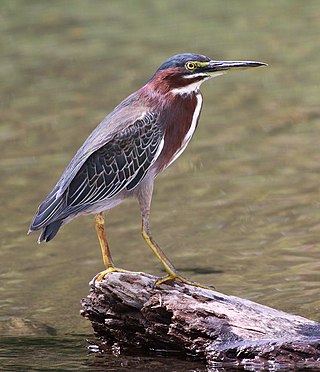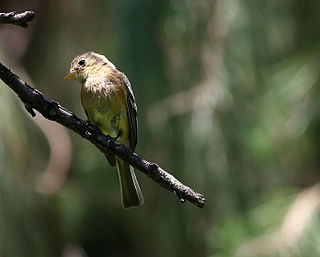
The Altamira oriole is a New World oriole. The bird is widespread in subtropical lowlands of the Mexican Gulf Coast and northern Central America, the Pacific coast and inland. They have since spread to southern Texas, but this was not until 1939.

The green heron is a small heron of North and Central America. Butorides is from Middle English butor "bittern" and Ancient Greek -oides, "resembling", and virescens is Latin for "greenish".

The blue-gray gnatcatcher or blue-grey gnatcatcher is a very small songbird native to North America.

The eastern phoebe is a small passerine bird. The genus name Sayornis is constructed from the specific part of Charles Lucien Bonaparte's name for Say's phoebe, Muscicapa saya, and Ancient Greek ornis, "bird". Phoebe is an alternative name for the Roman moon-goddess Diana, but it may also have been chosen to imitate the bird's call.

The eastern kingbird is a large tyrant flycatcher native to the Americas. The bird is predominantly dark gray with white underbelly and pointed wings. Eastern kingbirds are conspicuous and are commonly found in open areas with scattered trees and bushes, where they perch while foraging for insects. The Eastern kingbird is migratory, with its breeding range spread across North America and its wintering range in Central and South America.

The western wood pewee is a small tyrant flycatcher. Adults are gray-olive on the upperparts with light underparts, washed with olive on the breast. They have two wing bars and a dark bill with yellow at the base of the lower mandible. This bird is very similar in appearance to the eastern wood pewee; the two birds were formerly considered to be one species. The call of C. sordidulus is a loud buzzy peeer; the song consists of three rapid descending tsees ending with a descending peeer.

The olive-sided flycatcher is a small to medium sized passerine bird in the family Tyrannidae, the Tyrant flycatcher family. It is a migratory species that travels from South to North America to breed during the summer. It is a very agile flyer and mainly consumes flying insects on flight. Since 2016, this species has been assessed as being near-threatened globally (IUCN) and threatened in Canada (SRA) due to its declining populations.

The yellow-bellied flycatcher is a small insect-eating bird of the tyrant flycatcher family.

The alder flycatcher is a small insect-eating bird of the tyrant flycatcher family. The genus name Empidonax is from Ancient Greek empis, "gnat", and anax, "master". The specific alnorum is Latin and means "of the alders".

The willow flycatcher is a small insect-eating, neotropical migrant bird of the tyrant flycatcher family native to North America.

The great crested flycatcher is a large insect-eating bird of the tyrant flycatcher family. It is the most widespread member of the genus Myiarchus in North America, and is found over most of the eastern and mid-western portions of the continent. It dwells mostly in the treetops and rarely is found on the ground.

The American dusky flycatcher, or simply dusky flycatcher, is a small insectivorous passerine of the tyrant flycatcher family.

The black-throated green warbler is a small songbird of the New World warbler family.

The vermilion flycatcher is a small passerine bird in the tyrant flycatcher family found throughout South America and southern North America. It is a striking exception among the generally drab Tyrannidae due to its vermilion-red coloration. The males have bright red crowns, chests, and underparts, with brownish wings and tails. Females lack the vivid red coloration and can be hard to identify—they may be confused for the Say's phoebe. The vermilion flycatcher's song is a pit pit pit pidddrrrreeedrr, which is variable and important in establishing a territory. Riparian habitats and semi-open environments are preferred. As aerial insectivores, they catch their prey while flying. Their several months-long molt begins in summer.

The yellowish flycatcher is a small passerine bird in the tyrant flycatcher family. It breeds in highlands from southeastern Mexico south to western Panama.

Hammond's flycatcher is a flycatcher in the family Tyrannidae. This small insectivorous bird inhabits the coniferous and mixed forests of western North America. The name of this bird commemorates William Alexander Hammond who was the surgeon general of the US Army. Hammond collected bird specimens for Spencer Fullerton Baird.

The American gray flycatcher, or American grey flycatcher, or just gray flycatcher as it is known in North America, is a small, insectivorous passerine in the tyrant flycatcher family. It is common in the arid regions of western North America, especially the Great Basin. From sagebrush steppes to pinyon-juniper woodlands and ponderosa pine forests, this flycatcher forages for insects from shrubs or low tree branches.

The buff-breasted flycatcher is a small insectivorous bird. It is the smallest Empidonax flycatcher, typically ranging from 11.5 to 13 cm in size.

The western flycatcher is a small insectivorous bird in the family Tyrannidae. It is native to western North America, where it breeds in the Rocky Mountains and Pacific Coast forests and mountain ranges from California to Alaska, and winters in Mexico.

The least flycatcher is a small insect-eating bird. It is the smallest Empidonax flycatcher in eastern North America.






















